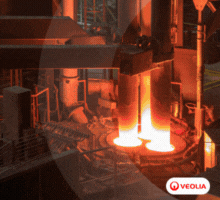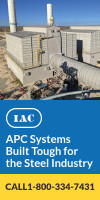VALE Reports 2007 Production
02/18/2008 - Companhia Vale do Rio Doce reports record production in 2007 of 296 million tonnes of iron ore, 17.6 million tonnes of pellets, and 247,900 tonnes of finished nickel, in addition to copper, bauxite, alumina, aluminum, kaolin, and cobalt.
Companhia Vale do Rio Doce (VALE) reported record production in 2007 of 296 million tonnes of iron ore, 17.6 million tonnes of pellets, 247,900 tonnes of finished nickel, 284,000 tonnes of copper, 9.1 million tonnes of bauxite, 4.3 million tonnes of alumina, 551,000 tonnes of aluminum, (1.3 million tonnes of kaolin, and 2,500 tonnes of cobalt.
The company said that its performance derives from the growth process set in motion since the beginning of this decade, through the development and conclusion of twenty large greenfield and brownfield projects in several segments of the mining industry, successful acquisitions, and productivity gains. The company achieved growth of 11.6%(1) per annum in total aggregate production between 2003 and 2007.
Carajas, a wealthy mineral province in the North of Brazil with the largest and the best iron ore deposits in the world, reached a historic level of production of one billion tonnes of iron ore production accumulated since the start-up in 1985. In its first year, Carajas produced just 4.5 million tonnes, and only achieved the level of 100 million tonnes of accumulated production in 1990. In 1994, the accumulated production reached 250 million tonnes, hitting the 500 million tonnes mark in 2000. The first 1 billion tonnes was achieved on October 25, 2007 and by year-end it had accumulated 1.019 billion tonnes.
The initial nameplate production capacity, 35 million tonnes, was reached in 1993, and in 1997 annual output was 43.8 million tonnes. Therefore, with the 91.7 million tonnes reached in 2007, Carajas iron ore production more than doubled over the last ten years, increasing by 109.4%.
Ferrous Minerals—VALE’s iron ore production reached a new record of 295.9 million tonnes in 2007, a 12.0% increase over 2006 production of 264.1 million tonnes. Challenges at the beginning of the year including Brazil’s rainy season and a lack of equipment were compounded by some production interruptions due to invasions by militant groups in November, resulting in volume that was below the programmed level of 300 million tonnes. The invasion problem was solved by the action of government authorities.
Between 2001 and 2007, the Company's annual production increased at an average annual rate of 14.1%, rising by 162 million tonnes over six years.
The Southeastern System, which encompasses the Itabira, Mariana and Minas Centrais iron ore mines, performed very well and was responsible for the production of 113.8 million tonnes, representing 38.4% of VALE’ total production in 2007. Brucutu produced 22 million tonnes, a performance consistent with the planned ramp-up. Brucutu is expected to achieve full capacity in 2008, producing 30 million tonnes.
The Southern System—comprising MBR and Minas do Oeste—produced 89.3 million tonnes in 2007, 5.9% higher than in 2006. Fourth quarter production decreased relative to the third quarter due to the heavy rainfall.
Fourth quarter production at Carajas, at 24.6 million tonnes versus 24.2 million tonnes in the third quarter, broke another record. In 2007, Carajas output reached a new record of 91.7 million tonnes, representing a 12.1% increase over the previous year's production.
Production at Urucum, located in the state of Mato Grosso do Sul, Brazil, suffered a reduction in comparison with the fourth quarter of 2006 due to the shutdown of a plant that resulted from of lack of sufficient barges in the Paraguay River.
Pellet Production for Quarter and Year—Pellet production totaled 17.6 million tonnes in 2007, as against 14.2 million tonnes in 2006, in response to strong global demand. Sao Luis restarted production in August 2006, and began operating at its new nominal capacity of 7 million tonnes/year; this capacity was even exceeded in the last quarter of 2007. Fourth quarter production of pellets reached an all-time high of 4.7 million tonnes, representing an increase of 6.4% compared with the same period a year earlier.
In 2007, VALE produced 11.2 million tonnes of blast furnace pellets and 6.4 million tonnes of direct reduction pellets. Fourth quarter production of blast furnace pellets amounted to 3.0 million tonnes, and direct reduction pellets, 1.7 million tonnes.
Adding the attributable production of non-consolidated joint ventures—Samarco, Nibrasco, Hispanobras, Itabrasco and Kobrasco—to the output figure for the company’s wholly owned plants, according to the rules of consolidation required by BR GAAP(2), fourth quarter pellet production amounted to 9.4 million tonnes, an increase of 4.1% compared with the fourth quarter of 2006. Production reached 36.0 million tonnes in 2007 as against 33.2 million tonnes in 2006, setting another all-time high level.
Aggregate production of the pellet plant group where VALE has stakes totaled 54.0 million tonnes, up 4.3% against 2006.
Manganese Ore and Ferroalloys Production—VALE’s production of manganese ore totaled 1.3 million tonnes in 2007, down 40.5% compared with 2006. The Azul mine produced 945,000 tonnes in 2007 versus 1.692 million tonnes in 2006. Operations at the Azul mine were suspended from July until mid- December to give total priority to the transport of iron ore on the Carajas railroad (EFC).
Fourth quarter manganese ore production was 118,000 tonnes, compared with 100,000 tonnes in the third quarter and 576,000 tonnes in the fourth quarter of 2006.
Alloy production in 2007 amounted to 542,000 tonnes, higher than the 534,000 tonnes produced in 2006. One of the furnaces of the company’s Dunkerque plant was shut down for maintenance in August and resumed operations by the end of October, implying a small reduction of the production.
In 2007, VALE’s ferroalloy production comprised 226,400 tonnes of high-carbon manganese alloys (FeMnAc), 220,700 tonnes of ferrosilicon manganese alloys (FeSiMn), 58,100 tonnes of medium-carbon manganese alloys (FeMnMC) and 28,900 tonnes of other types of alloys (CaSi). Production of cored wire (specialty alloys) was 8,000 tonnes. On June 5th, 2007, Vale sold CaSi, located in Minas Gerais, Brazil, and the cored wire plant, located in Dunkerque, France.
Non-Ferrous Minerals Production: Nickel—VALE’s finished nickel production reached an all-time high in 2007, at 247,900 tonnes, rising 5.6% relative to 2006(4). This performance highlights the successful integration of the former Inco Ltd., acquired by VALE in October 2006.
Volume produced in the fourth quarter, 69,000 tonnes, represents a 25.3% increase compared to the third quarter, and a 5.8% increase over the previous record reached in the fourth quarter of 2006, of 65,200 tonnes.
All the operations, with the exception of Sudbury, showed a strong increase in production in the fourth quarter as compared to the previous quarter.
Nickel output in the third quarter of the year tends to be negatively affected by the summer vacations in the Northern Hemisphere, where most of VALE's production is originated. By the same token, global stainless steel production, responsible for 64% of world nickel consumption, is weaker at that time of the year.
In addition to the seasonal recovery, a number of operational challenges were overcome, which had contributed to a much better performance in the last quarter of 2007.
Finished nickel originated from the Sudbury Basin, in the province of Ontario, was 82,700 tonnes in 2007, 11,000 tonnes lower than the level reached in 2006, as a result of maintenance shutdowns, adjustments to equipment and problems with kiln #1 at the Clydach refinery, located in Wales, U.K. Clydach is responsible for 30% of the production of finished nickel at Sudbury.
Sudbury’s production remained flat in the fourth quarter, at 19,300 tonnes. However, it was lower than the figure in fourth quarter of 2006, when production amounted to 24,600 tonnes. The decrease is partially explained by the lower feed grade, below the programmed levels, which contributes to reduced finished nickel output. The company is are investing and working to eliminate this problem at the Copper Cliff Smelter in 2008.
Production at Thompson, in the Province of Manitoba, was 30,000 tonnes in 2007. In the fourth quarter, it grew significantly, 49.1% over the last quarter, totaling 8500 tonnes.
Voisey's Bay, located in the province of Newfoundland and Labrador, completed its ramp-up, producing 20,500 tonnes in the fourth quarter, coming to a total of 58,900 tonnes in 2007 as a whole. Nickel concentrate produced at Voisey's Bay is processed at Sudbury and Thompson.
VALE produces nickel matte at Sorowako, in the island of Sulawesi in Indonesia, which houses the largest lateritic nickel operation in the world. Matte, an intermediate product with 78% nickel content, is processed into refined nickel at VALE’s refinery in Tokyo, Japan. Production of nickel-in-matte was 75,800 tonnes in 2007, compared to 70,000 tonnes the previous year. Despite the labor strike that occurred in the Indonesian operations in November 2007, it managed to achieve a new quarterly production record of 20,600 tonnes.
VALE, with 11.3 million tonnes of contained nickel distributed in four countries (Brazil, Canada, Indonesia, and New Caledonia), enjoys a significant growth potential. Three projects are currently under development: Goro, in New Caledonia, Onca Puma, in Brazil, and Totten, in Canada. Goro, with an estimated nominal capacity of 60,000 tonnes and 4,700 tonnes of cobalt per year, is the largest nickel project being developed in the globe and is expected to come on stream late this year.
Copper, Cobalt, Potash, and Kaolin Production—VALE's copper concentrate production totaled 284,200 tonnes in 2007, setting a new record and a 6.6% increase relative to 2006.
Cobalt production, driven by the good performance of Voisey's Bay, Ovoid mine, reached a record 2,524 tonnes in 2007, representing a 27.6% increase relative to last year. By contrast, the production of platinum group metals (PGMs) saw a drop in production. Platinum and palladium output decreased by 8.7% and 8.0%, respectively in 2007, as a consequence of the operational performance at the company’s Sudbury operations.
Annual production at Taquari-Vassouras reached 671,000 tonnes in 2007. Performance of the company's potash operations was adversely affected by problems with mining equipment in the first half of the year. Snce 2006, the company has been mining a section that has lower grades. The geological condition of the deposits, in contrast with the case of ferrous minerals, does not allow for a rapid change in grades.
In 2007, VALE's production of Kaolin reached 1.4 million tonnes, in line with the levels of 2006.
Aluminum, Alumina, Primary Aluminum Production—VALE’s bauxite production hit an all-time high of 9.1 million tonnes in 2007, 28.4% above the previous record of 7.1 million tonnes in 2006. (In accordance with US GAAP, only production from Paragominas, a wholly owned VALE asset, is considered.)
The new Paragominas bauxite mine, in the state of Para, which began operations in April and is still in the ramp-up phase, produced 1.9 million tonnes in 2007. Paragominas should become one of the largest bauxite operations in the world.
The Paragominas ramp-up and production increase in bauxite at Trombetas allowed the Barcarena refinery to produce 4.3 million tonnes of alumina in 2007, 8.0% higher than the previous year, setting another record. Barcarena attained its full production capacity, which had been increased by the construction of stages 4 and 5 to 4.3 million tonnes per year.
Production of primary aluminum was 551 thousand tonnes in 2007, in line with the previous year, given that there has been no increase in production capacity.
Coal Production—Vale Australia, a wholly owned subsidiary, owns four coal assets: Integra Coal (61.2%), Carborough Downs (80%), Isaac Plains (50%), and Broadlea (100%), all of which are classified as unincorporated joint ventures, characterized by a structure of shared results. VALE has revised its coal production figures, according to FASB, which determines that the consolidation in this case must be proportional to Vale's equity stake in each joint venture, for the conversion to USGAAP.
Coal production was 2.2 million tonnes in 2007, including 1,764,000 tonnes of metallurgical coal and 440,000 tonnes of thermal coal. Problems caused by flooding on the Hunter River in Australia, in June, which adversely affected production at Integra Coal, were not eliminated until September.
Power Generation—Vale invests in power generation to meet its own consumption, in order to mitigate the risks of price and supply volatility and to reduce costs. In Brazil, it owns stakes in several consortia that own and operate eight hydroelectric power plants: Igarapava, Porto Estrela, Funil, Candonga, Aimores, Capim Branco I, Capim Branco II and Machadinho . All of them are located in the state of Minas Gerais, with the exception of Machadinho, in the state of Rio Grande do Sul.
In Indonesia, VALE owns and operates two hydroelectric power plants, Larona and Balambano, in the Larona River, at Sulawesi. The company also has some small hydropower plants in Brazil and Canada and in-site power generation facilities.
In 2007, VALE’s plants generated 5.714 million MWh, meeting 24.5% of the company's total consumption of electricity.
VALE also owns 30% of a consortium that is building the Estreito hydropower plant, in state of Tocantins, Brazil. Estreito will have a capacity of 1,087 MW. In Indonesia, Vale is building a third hydroelectric plant at the Larona River, Karebbe, with 130 MW. The company is also building a coal-fired 600 MW power plant, Barcarena, in the state of Para, Brazil.
Logistics—VALE’s railroads (EFC, EFVM and FCA) carried 27.5 billion net ton kilometers of general cargo for clients, representing a 3% increase over 2006.
NOTES:
(1) Index encompassing the production of all products produced by Vale, expressed in equivalent iron ore production unit basis
(2) According to the BR GAAP rules, production of non-consolidated affiliates and joint ventures is computed proportionally to Vale's equity stake in each of these non-consolidated companies.
(3) The figures shown for finished nickel production do not include the quantities produced from nickel concentrates purchased from other companies and processed externally under tolling arrangements. These volumes were 14.2 thousand tonnes in 2007 and 17.0 thousand tonnes in 2006



.jpg?lang=en-US&ext=.jpg)
-(1).gif?width=220&height=200&mediaprotectionhash=8011a71ede637cd523c67b1296fc49e6151560fde821a46f29cc85998cc76615&ext=.gif)



